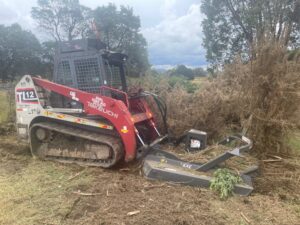
Gorse Blackberry Slashing Services – Victoria
Gorse is a Weed of National Significance. It is regarded as one of the worst weeds in Australia because of its invasiveness, potential for spread, and economic and environmental impacts. It is a major agricultural weed in Tasmania and parts of Victoria, and is increasingly becoming a threat as an environmental weed in many national parks and other bushland areas. In pastoral areas it provides shelter for pests such as rabbits, increases the risk of bushfires because of its flammability, reduces access by forming dense thickets and dramatically reduces stocking rates.
In Tasmania the cost of gorse to the state’s woolgrowers in lost production alone has been conservatively estimated at about $1 million annually. In Victoria
the costs of gorse to the community in the central highlands region were recently estimated at $7 million over five years. Control of gorse, like all weeds, requires persistence, with initial costs of between $200 and $1000 per ha and requires ongoing follow-up treatment of seedlings. The weed Gorse is a prickly, perennial, evergreen legume which, if left undisturbed, will grow to a height of more than 3 m. It produces deep and extensive roots. All its stems and leaves are prickly, ending in a sharp spine. The plant produces huge numbers of brown to black seeds in grey hairy pods, each pod holding three or four seeds. The seeds have a hard, water-resistant coating which allows them to remain dormant in the soil for up to 30 years.
The small dark green leaves are stiff and covered with a waxy coat, which helps reduce water loss. Together with its deep root system, this feature enables gorse to flourish in areas with very low rainfall. The bush is covered with bright yellow, pea-like flowers. In spring it is one of the first species to flower, and
beekeepers believe it is an important source of pollen.
The Victorian Gorce Task Force has a comprehensive guide on the eradication of Gorse.
The Victorian Blackberry Task Force has a comprehensive guide on the eradication of Blackberry.
Slashing
Regular slashing or mowing is not effective in eradicating gorse. It will eliminate most seed production and keep plants at a low height but they will grow back vigorously once slashing stops.
Herbicides
Apply herbicide when plants are actively growing (during spring to early summer and after autumn rain). Check for regrowth in 12 months. Do not spray when plants are in full flower or when bees are active.
Apply herbicides during periods of active growth Herbicides can be effectively applied, either directly to leaves when plants are at least 500 mm high or painted onto cut stumps. There are a number of registered chemicals and they work best if applied when plants are actively growing (during spring to early summer and after autumn rain). In dense stands you may need to clear access paths to get complete coverage.
Do not apply sprays when plants are in full flower or when bees are active. Check treated bushes 12 months after herbicide application and treat any regrowth.
In wasteland areas herbicides are often the only practical method, together with encouragement of native species regrowth.



